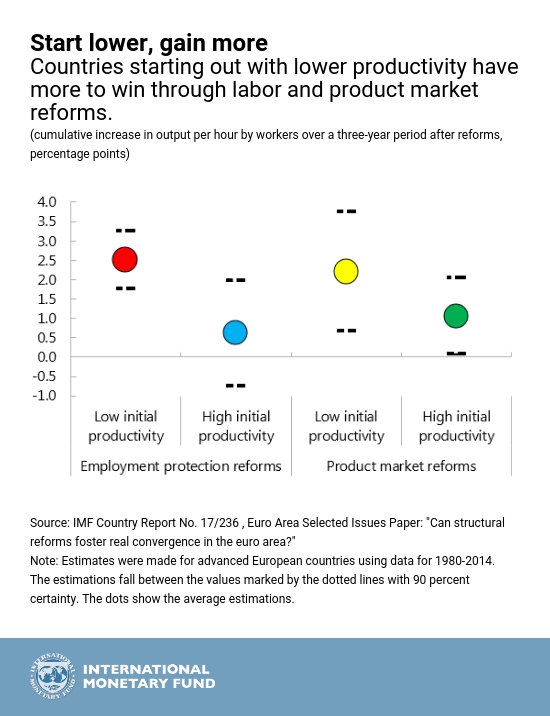September 22, 2017
[caption id="attachment_21362" align="alignnone" width="1024"] Structural reforms can jumpstart productivity in countries with weaker initial productivity, and help them catch up with their peers (photo: The Palmer/iStock).[/caption]
Structural reforms can jumpstart productivity in countries with weaker initial productivity, and help them catch up with their peers (photo: The Palmer/iStock).[/caption]
Labor and product market reforms, which make economies more efficient, can benefit all countries. But they are especially helpful in jumpstarting productivity in countries where productivity is weaker. This is good news as it implies that reforms are one route through which countries with lower per capita incomes can catch up with richer countries instead of persistently lagging behind: economic hardship is not destiny. Our new paper provides fresh arguments in favor of the often-difficult structural reforms.
Structural reforms—the retooling of the regulations and structures that govern a country’s economy—remain politically and socially difficult to implement in many countries, because transitioning to the new regime may create winners and losers from adjustment. This is universally true, including in the euro area. Our study looks into which countries gain most from structural reforms and why, thereby once again making the case for such reforms, despite their associated costs.
The least efficient gain the most
Based on data for advanced economies from 1980 to 2014, our study shows that the less efficient a country is when it introduces reforms, the bigger the efficiency gains it reaps in comparison with more productive countries.
That is, countries that need reforms the most also benefit the most from reforms.
To illustrate, workers in less productive countries can, on average, produce higher output per hour over three years (red dot in figure)—an estimated labor productivity gain of 2½ percentage points—after governments remove excessive job protection for workers with regular contracts, and thus make it easier for firms to hire more productive workers. In contrast, the average gains for high‑efficiency countries over the same period is smaller, and statistically closer to zero (blue dot).
Product market reforms such as slashing red tape to make it easier to set up businesses, yield similar results. All countries reap productivity gains from these reforms, but the benefits accruing to low‑productivity countries are much larger on average than to countries which were highly efficient at the time of reform (yellow dot versus green dot respectively in the figure).
Better matching of resources
One intuition for these results is as follows. If there are less complex rules governing how workers can take up or leave jobs, and how firms can enter or exit certain sectors, then the more efficient firms will be able to attract capital and high-quality workers, while failing firms will gradually close down. The folding of unprofitable companies creates space to attract new firms and help unleash innovation.
The reshuffling of resources thus boosts the efficiency of the economy and increases its maximum capacity. Low-productivity countries have less flexible and less efficient markets to begin with, therefore the reshuffle provides greater scope for reallocating resources and, thereby, larger gains from reforms.
Leapfrogging
A second, related channel could also be at work: allowing countries lagging behind to leapfrog over more efficient countries to the current best practice. For instance, state-of-the-art reforms in regulations, technology and digital infrastructure help all countries gain by allowing them to close the gap between their initial conditions and the frontier of economic possibilities. However, such reforms provide a bigger boost in less productive countries because they are further away from the frontier and can close the gap by merely embracing the latest innovations developed elsewhere, skipping intermediate steps.


